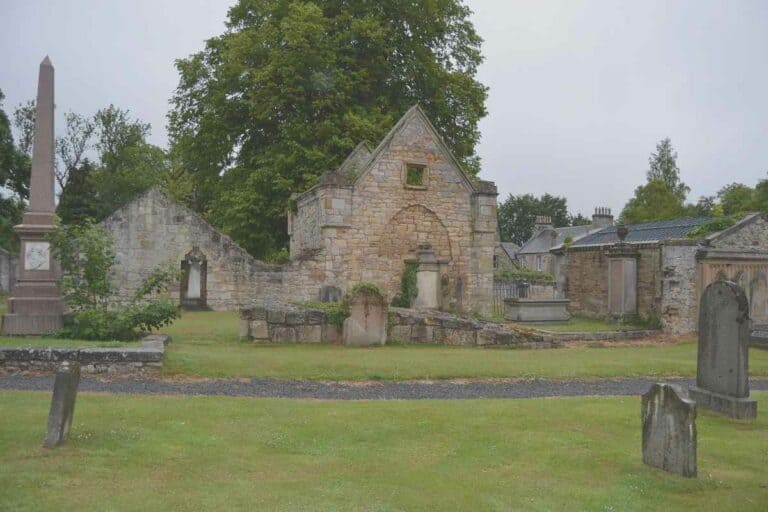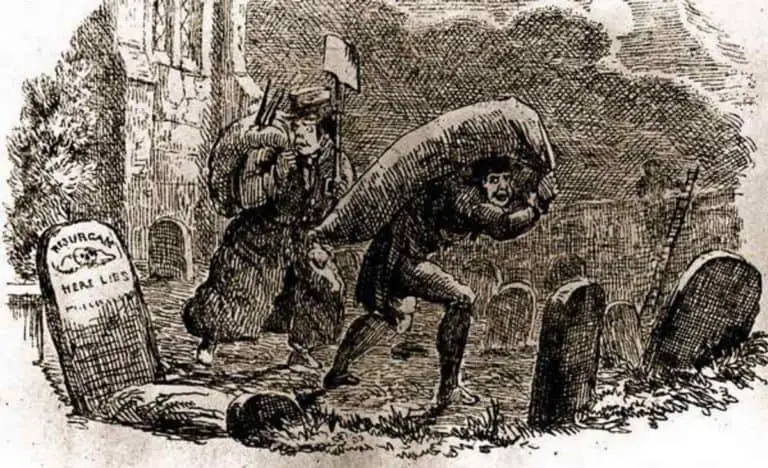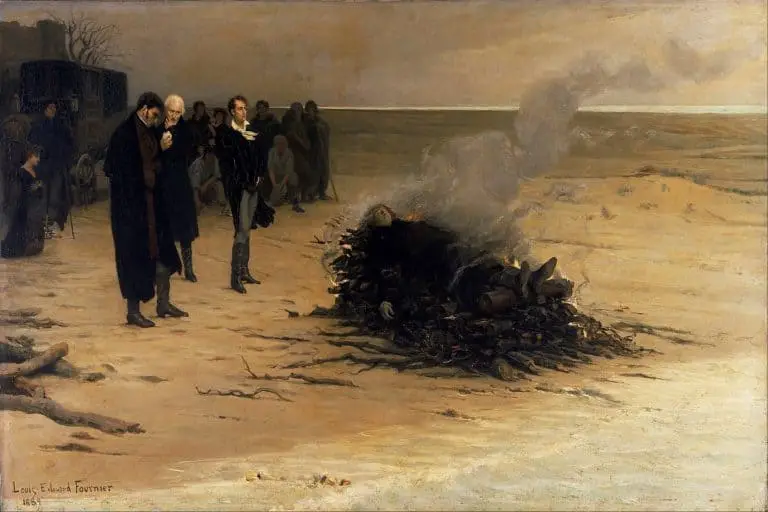Edinburgh Graveyards Not To Be Missed in Edinburgh Old Town
What if your trip to Edinburgh’s Old Town could take in some of the oldest and creepiest graveyards in Edinburgh and you could do it all on foot!
After visiting ALL of the graveyards in this guide I’d love to share with you Edinburgh’s finest graveyards, tell you the graves you should be looking at (in my opinion) and drop in the odd haunting here and there for good measure.
Get ready to step into a world of ghosts and body snatchers, to discover the graves that gave Charles Dickens and J.K. Rowling inspiration for their most notorious characters, and take a night tour of the world’s most haunted graveyard if you dare.

Edinburgh had to bury its dead somewhere and its oldest graveyards remind us of a time when even the dead weren’t safe, and where murder, poverty and imprisonment are remembered forever if you know where to look.
I mention the term Kirk throughout this post and if you’re not familiar with it or with the term Kirkyard then you may not know that it’s the Scots word for church. It’s used solely for the Church of Scotland. The Kirkyard, of course, is the burial ground surrounding the Kirk.
EDINBURGH GRAVEYARDS NOT TO BE MISSED
If you’re interested in checking out a terrific little book to take with you as you do your church crawling, then tuck a copy of The Graveyards & Cemeteries of Edinburgh under your arm.
It’s one of two books I’d recommend by the author Charlotte Golledge*, a local historian. Her other book is Greyfriars Graveyard mentioned below.
Table of Contents
- Greyfriars Kirkyard | Candlemaker Row | EH1
- Canongate Kirk | Canongate | EH8
- Old Calton Burial Ground | Waterloo Place | EH1
- New Calton Burial Ground | Regent Street | EH7
- St Giles’ Cathedral: The High Kirk of Edinburgh |High Street | EH1
- The Tron Kirk | High Street | eH1
- Edinburgh Castle Dog Cemetery | Castlehill | EH1
- St Cuthbert’s Kirkyard | Lothian Road | EH1
- Buccleuch Parish Burial Ground | Chapel Street | EH8
- East Preston Street Graveyard | East Preston Street | EH8
Greyfriars Kirkyard | Candlemaker Row | EH1
KIRKYARD OPEN: 24 Hour Access
COST: Free
ACCESS & RESTRICTIONS: Easy access with lots of paths, Few slopes on site. Tours are needed for certain areas but otherwise, free to wander
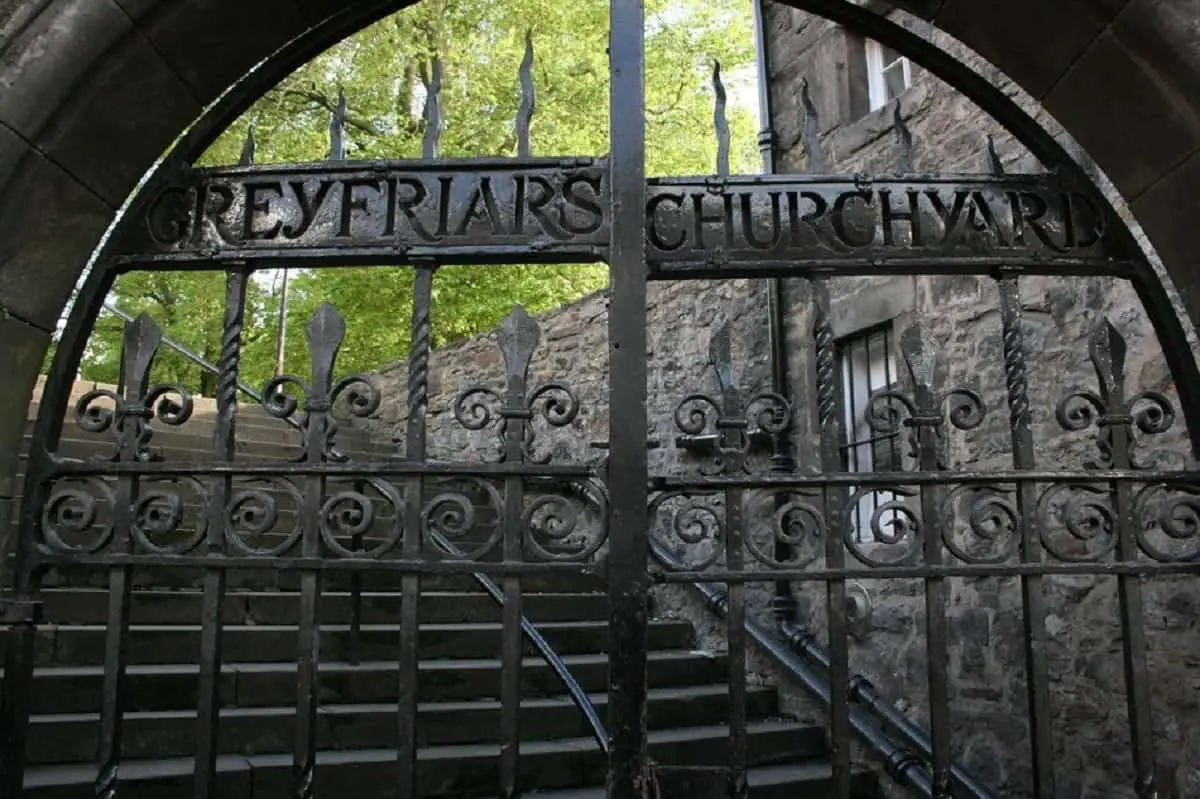
Home to Edinburgh’s most active poltergeist and reputed to be the world’s most haunted graveyard, you’ll find Edinburgh Greyfriars at the top of any graveyard guide to the city. Or you should do anyway.
Founded in 1562 Edinburgh Greyfriars is named after the colour of the habits worn by the monks of the former Franciscan monastery that once stood on the site. There are nearly 100,000 people buried here and over 700 gravestones. As well as being the most haunted place in the world, it was also the inspiration for characters in the Harry Potter novels and the final resting place for the loyal Skye Terrier, Greyfriars Bobby.
Come here more than once and I can guarantee that you’ll see something new each time. An extra scratch on Mackenzie’s tomb or the initialed gravestone in the area formerly known as the Criminals Ground.
Sometimes it takes a few visits to a place to really get to know it.
THE MOST HAUNTED CEMETERY IN THE WORLD
People come to Greyfriars Kirkyard for two things. To see the grave of Greyfriars Bobby or to be scared out of their wits on a ghost tour.
If you’re a regular to my site you’ll know that I’m way too scared to be joining one of Edinburgh Greyfriars infamous ghost tours, but I’m in no doubt that you’re a lot braver than me and so here’s my round-up of the top things to see in Greyfriars.
You can read more about the graves I recommend here in a little more depth, then stay a while and read my guide to macabre and spooky graves to see in Greyfriars.
THE BEST OF EDINBURGH: GREYFRIARS GRAVES NOT TO BE MISSED
THE BLACK MAUSOLEUM & THE MACKENZIE POLTERGEIST
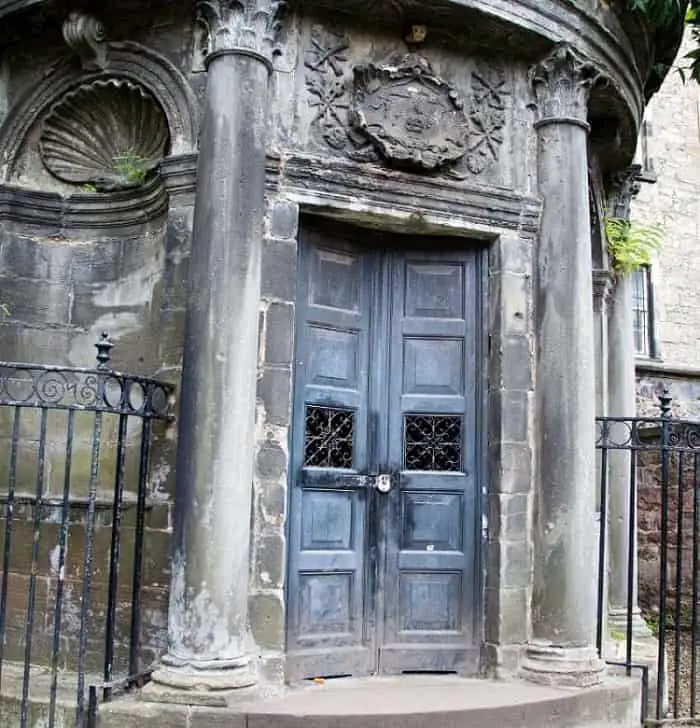
The infamous poltergeist who regularly scratches or bruises visitors getting a little too close to his tomb is the notorious George Mackenzie, aka ‘Bloody Mackenzie’ and is probably the main reason why those searching for the macabre visit Greyfriars at night.
As Lord Advocate, (the Senior Scottish Law Officer) Mackenzie is most remembered for persecuting Covenanter’s during the reign of Charles II.
Such was his zeal for his new office that he is said to be responsible for imprisoning and torturing over 1000 Scots in an area of the Kirkyard that is now known as the Covenanter’s Prison. More about this below.
Only one tour company is granted access to the Black Mausoleum as well as the Covenanter’s Prison and that’s the award-winning City of The Dead Tours.
If a tour group meets at the ‘Tree of the Dead’ and their office is the former watchhouse in the graveyard itself, then you know they’re gonna be good.
All of their tours are extremely popular and sell out fast and booking is highly recommended.
FANCY BEING SPOOKED?
If the thought of heading around Greyfriars has got you interested to experience more of Haunted Edinburgh, then take a look at these tour options below.
I’m proud to say that I actually went on The World Famous Underground Ghost Tour… never again mind you!
BODY SNATCHING PREVENTION
Body snatchers plagued the streets of Edinburgh, and Britain, during the 18th and early 19th centuries, dragging a corpse from its coffin and selling it to the anatomists all in the name of medical science.
Edinburgh’s attempts at disrupting this illegal trade can be seen throughout Greyfriars, where three types of body snatching prevention can be found.
CAGED LAIRS
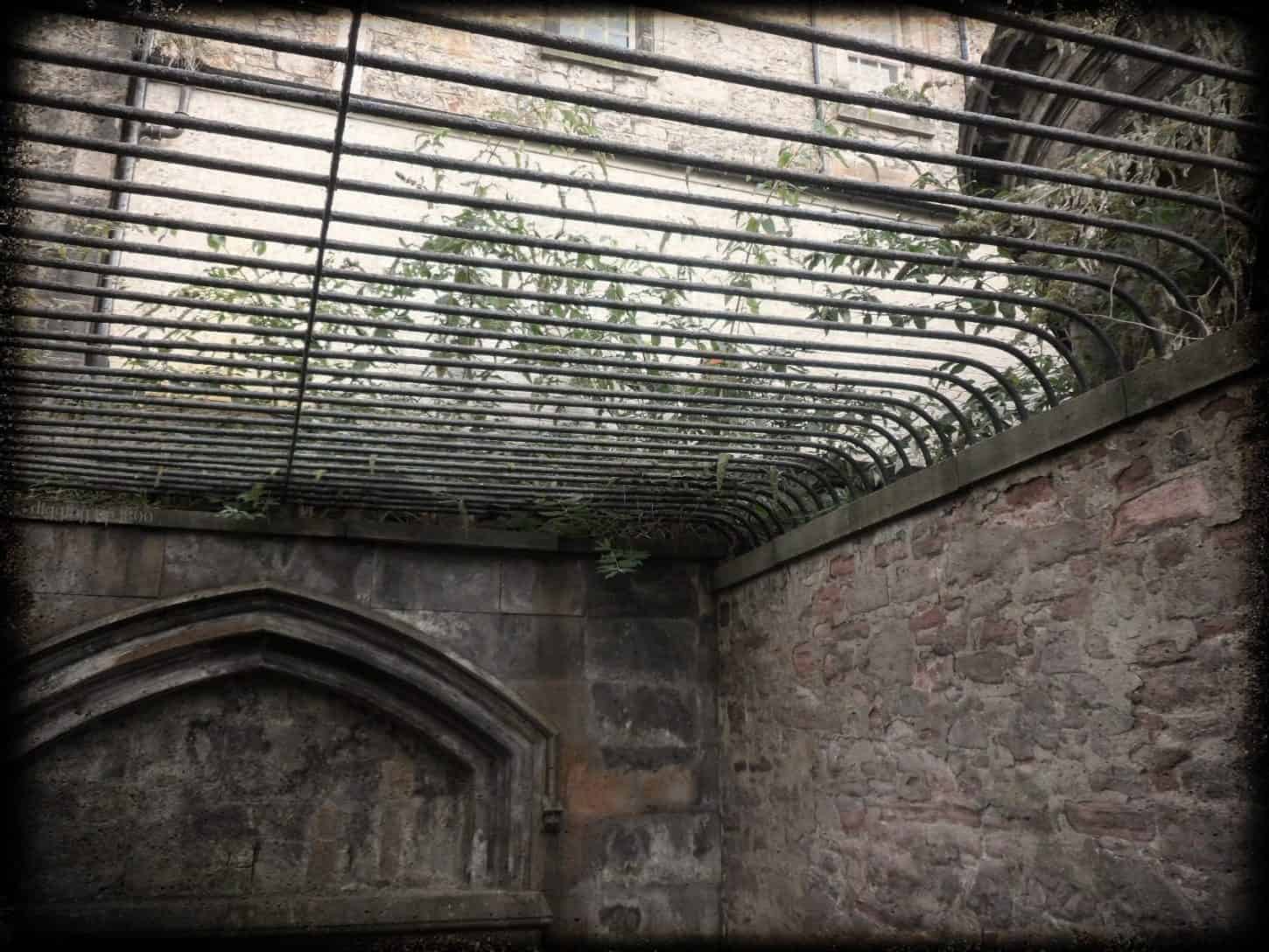
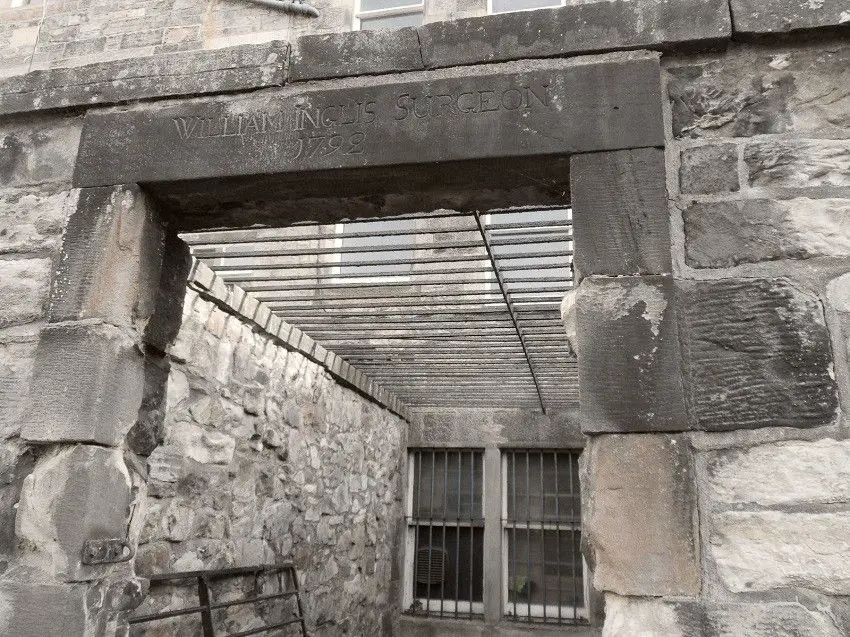
Without stopping at Bobby’s grave or walking over to the ‘Dancing Skeleton’, take a left as you enter the graveyard instead and head for the far perimeter wall.
It’s lined with perhaps the ultimate form of body snatching prevention, the caged lair.
You’re lucky, for here you can step inside the lairs, elsewhere in Edinburgh this presents some problems, but in Greyfriars, you can wander freely in and out of someone’s final resting place.
Look up and you’ll notice iron slats have survived across the roof of some. This was designed to stop the body snatchers from climbing onto the roof and getting access to the grave.
Body snatching prevention such as this was reserved for the rich of the city, only the best for them, but you’ll notice as you wander along, a lair belonging to the surgeon William Inglis who died in 1792.
He’d no doubt have been privy to the antics of Edinburgh’s resurrection men, knowing that fresh cadavers were a hot commodity in the city. This is one surgeon who has no intention of ending up on the dissecting table.
MORTSAFES
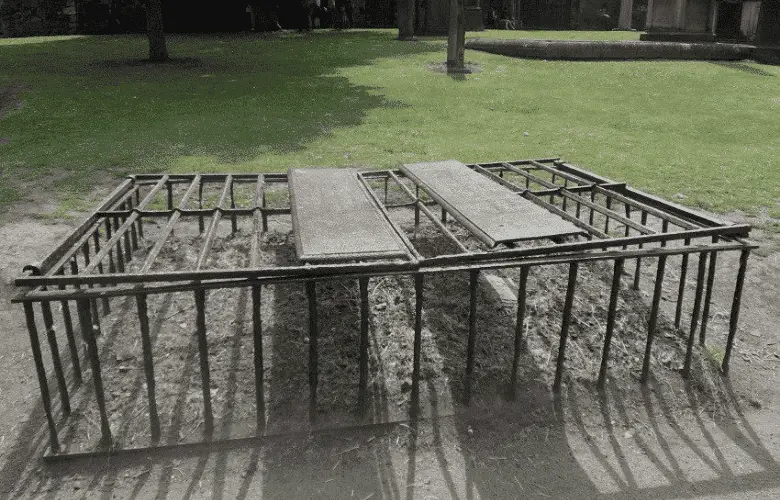

Unique to Greyfriars, the ‘double- bedder’ mortsafes that offer some visitors a welcome rest, can be found alongside the main path to the left of the Kirk.
Dating to a time when Burke and Hare were still on the minds of Edinburgh folk, the mortsafes here, encase more than one grave.
Rare survivors from a darker period in history, they date from 1837 and 1838, a period just after the Anatomy Act when body snatching was meant to have come to an end.
Mortsafes are predominant in Scotland and many took on second roles once body snatching has ceased to be such a threat. If you want to find out more, take a look at my post Mortsafes: After The Anatomy Act
COVENANTER’S PRISON
Lying in the top left-hand corner of Greyfriars is perhaps one of the saddest places in the kirkyard.
The Covenanter’s Prison, with one side of the enclosure being made by the Flodden Wall, is where in 1679, up to 1000 men and women were kept alive on a ration of only 4 ounces of bread a day. Dubbed the ‘Killing Times’, the crime these individuals committed was to support The National Covenant and defend the established religion in Scotland.
Locked to the public since 1990, access is now only permitted with City of The Dead Tours.
Of the 1000 people imprisoned here, only 257 survived after pledging loyalty to the Crown. They were sentenced to deportation and sold as slaves.
As they made their way out of Edinburgh on a boat bound for the Orkney Islands, their ship was wrecked and 209 men on board lost their lives. A memorial to those lost can be seen on the island.
The graves that you’ll see inside the Prison date from 1705 and are not the graves of any of the Covenanter’s themselves.
MEMENTO MORI
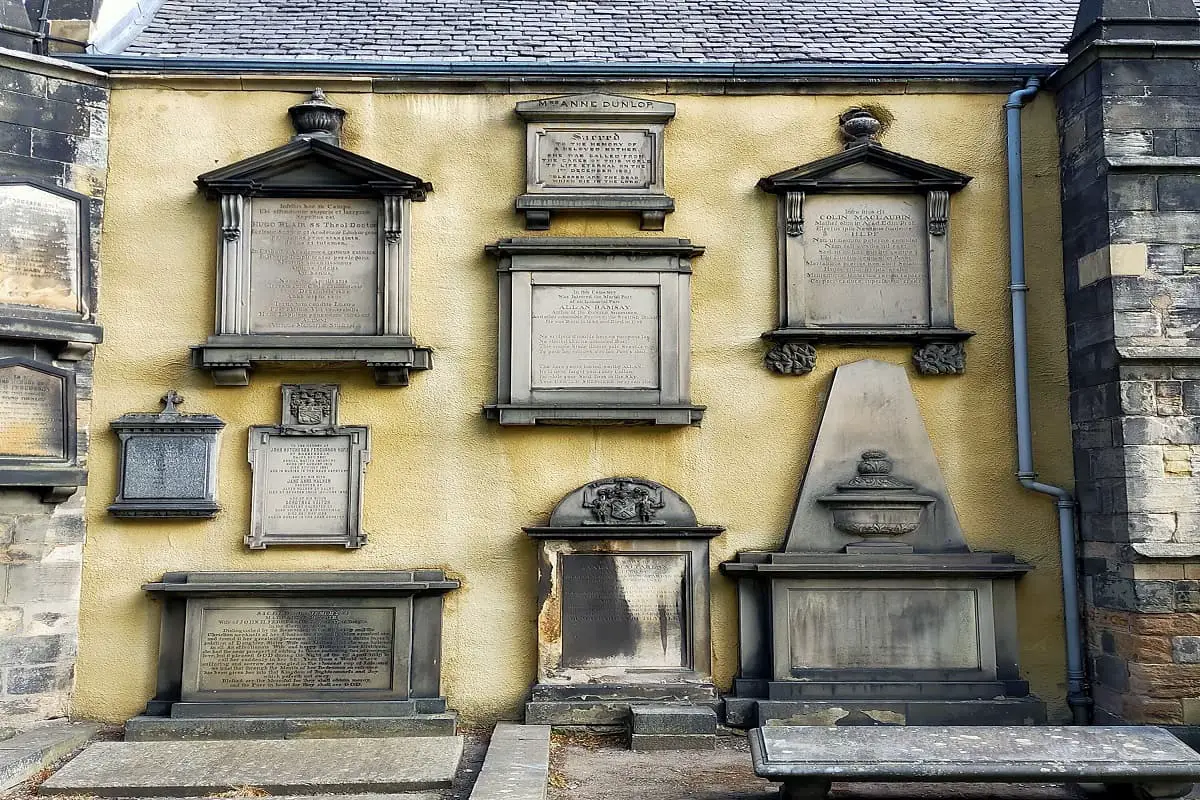
It’s safe to say that memento mori symbolism is everywhere in Greyfriars and it’s probably easier for me to tell you where you won’t find it than point out the bits where you can.
There are of course some graves that simply leave the others standing and should be stood in front of and gazed at for more than a few minutes.
These include:
If you’d like help deciphering the meanings behind the memento mori symbols then Golledge’s Greyfriars Graveyard is great for this. So it Betty Willsher’s ‘Understanding Scottish Graveyards’
THE GRAVE OF GREYFRIARS BOBBY

No visit to Greyfriars is complete without paying homage to the grave of Greyfriars Bobby.
Greyfriars Bobby, a loyal Skye Terrier, whose statue stands on the corner of Candlemaker Row, sat next to the grave of his master, John Gray, for over 14 years until passing away in 1872. His grave can often be found with a pile of sticks on it, a symbol of remembrance for those who’ve also lost their pets.
It’s a tradition that stems from the 1980s, according to Golledge, and you may occasionally find a wee collar place upon his grave. My heart I think would break if I saw such a thing.
Bobby’s grave is the red gravestone you see as you enter Greyfriars. If you want to keep the dream of Greyfriars Bobby alive, then DON’T read Black Markers!
Oh and just one request from the people of Edinburgh, if you do walk past Bobby’s statue, please don’t rub his nose!
THE GRAVE OF THE REAL TOM RIDDELL
He-Who-should-Not-Be-Named, aka Lord Voldemort, aka Tom Riddell is a character known to Harry Potter fans the world over for being created after J.K. Rowling saw a certain gravestone in Greyfriars.
In the area behind the Flodden wall, at a grave where the grass no longer grows, lies the grave of the real Tom Riddell.
I’m not sure what inspired Rowling to use this particular grave, I’m sure it’s on the internet somewhere, but whatever the reason, if you do visit, please remember that he was a real person.
The ground has already been damaged by loyal Potter fans over the years, and you are encouraged to keep to the paths.
Did you know you can actually take a Potter Tour while you’re in Edinburgh?
There’s a vast amount to choose from, but one of the simplest (in regard to meeting) and best value for the price seems to be the Edinburgh Harry Potter Walking Tour.
Not only does it take in the real Diagon Alley, but also swings past the grave of the real Tom Riddell.
I’ve not been on it myself, but it’s had great reviews.
Canongate Kirk | Canongate | EH8
KIRKYARD OPEN: 24 Hour Access
COST: Free
RESTRICTIONS: Slightly sloping site but good paths in most places
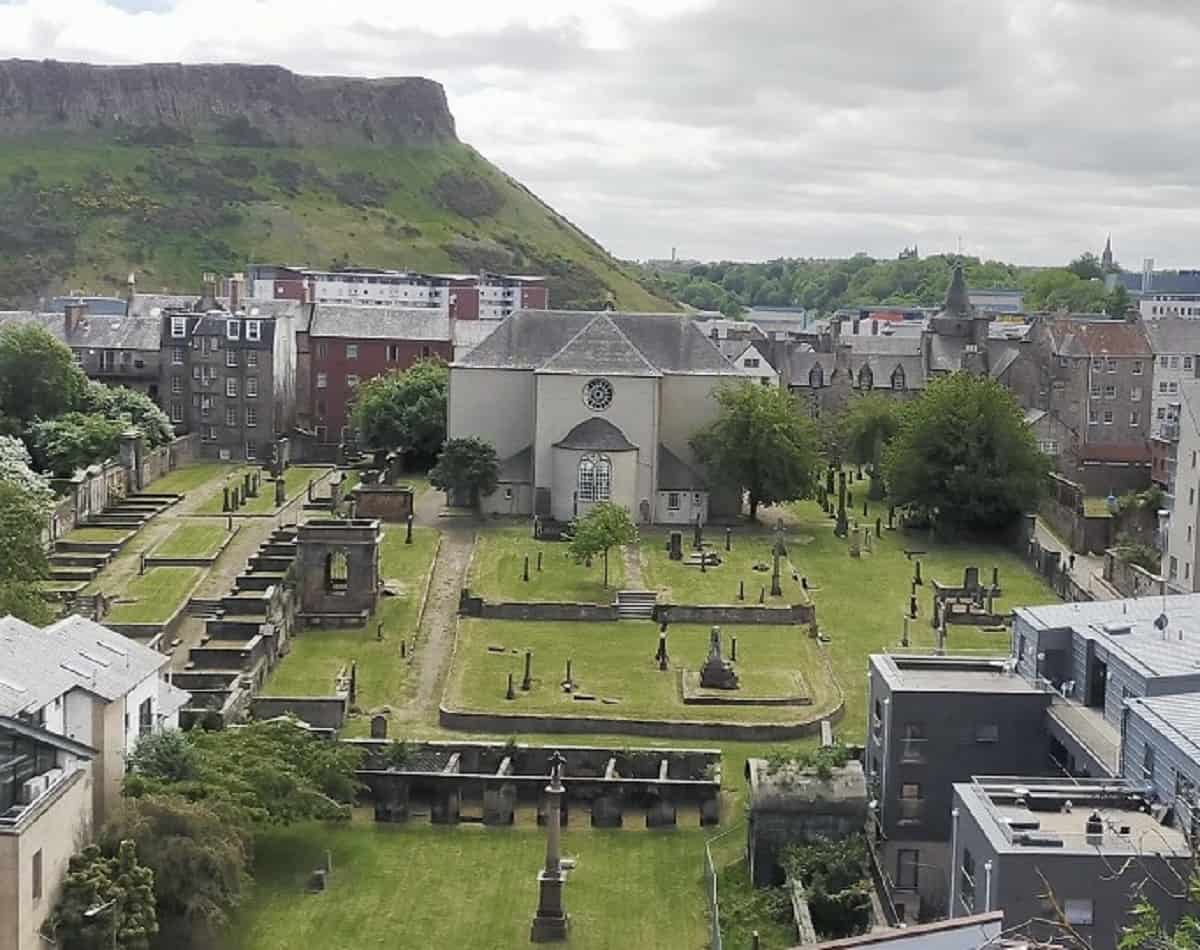
At the lower end of the Royal Mile, lies a graveyard steeped in history.
Opened in 1691, Canongate Kirkyard is home to the Crying Woman and the place where Charles Dickens found inspiration for one of his most famous characters.
Canongate Kirk, an austere post-reformation kirk built in 1686 when Holyrood Abbey was transformed into a Roman Catholic Chapel Royal. The parishioners of Canongate were asked to worship elsewhere and Canongate Kirk was formed. Notable graves include that of David Rizzio, musician to Mary Queen of Scots and Robert Ferguson, the poet who gave us ‘Auld Reekie’.
It is said that the kirk itself can be a disappointment to those who visit. I’ve not actually ventured inside but the outside of the building is a little disappointing I must agree.
One of my favourite descriptions of the site has to be in Black Markers, a book all about the dark history of Edinburgh, told through its graveyards.
The kirk is described by the author as a ‘giant, stone carriage clock’ and once seen, it’s hard to erase this image.
THE KIRKYARD
Lingering in Canongate Kirkyard and taking in the various gravestones isn’t something that will take all day but I would encourage you to walk toward the back of the site where a series of caged lairs can be found.
Before you leave, however, make sure you hunt out the following graves which are of National interest.
DAVID RIZZIO
The grave of David Rizzio/Riccio, musician to Mary Queen of Scots is said to be here, maybe. He was murdered by her husband, Lord Darnley on 9 February 1566 and is buried in a rather non-descript plot to the right of the Kirk as you face the site.
I say maybe because there is some belief that his body is still buried at Holyrood Abbey and wasn’t re-interred at Canongate as is traditionally thought. Today a monument marks the spot.
ROBERT FERGUSSON
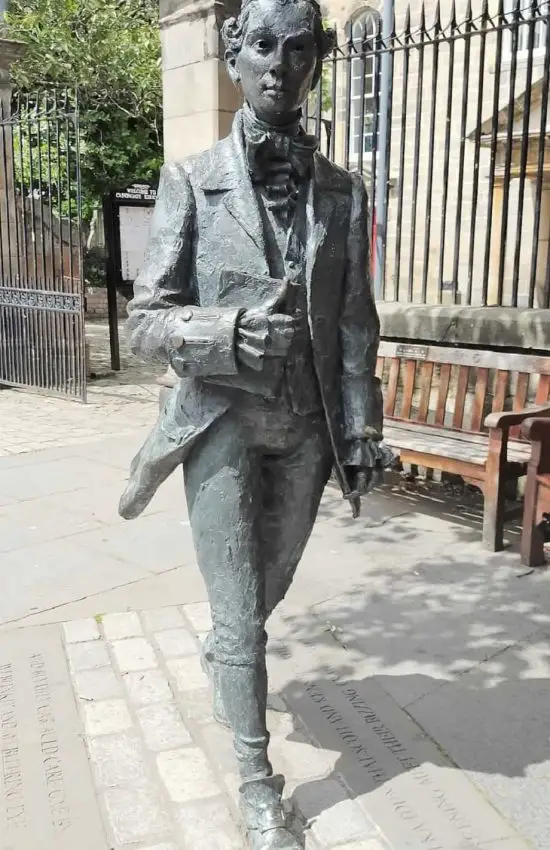
Robert Fergusson, the Edinburgh poet who wrote Auld Reekie, a name now synonymous with Edinburgh, is buried here.
Scotland’s much-loved poet, Robert Burns commissioned the headstone after Fergusson was buried in a pauper grave.
His statue now stands outside the Kirkyard and is photographed as much, if not more, than the Kirkyard itself.
WHY IS EDINBURGH CALLED AULD REEKIE?
Today, Edinburgh is known just as much by its nickname, Auld Reekie, as it is by its official name, but where did this actually come from?
‘Auld Reekie’ translates from the Scots as ‘Old Smokey’. Auld means ‘old’ and Reekie means ‘smokey’. The name was used in the 16th and 17th centuries when Edinburgh residents lived in tightly packed areas of the Old Town. Relying heavily on coal and peat fires, the smoke produced clung to the brickwork of the buildings and hung heavy in the air causing a thick smog to hang over the city.
CHARLES DICKENS & EBENEEZER SCROOGE
Canongate’s other claim to fame, in literary circles at least, is as the place where Charles Dickens found the inspiration for perhaps one of his most famous characters, Ebeneezer Scrooge, in A Christmas Carol.
After misreading the gravestone of Ebeneezer Scroggie who died in 1836, Dickens took what he saw and built his now-infamous character around it.
He’d taken Scroggie’s profession of meal merchant or ‘meal man’ to have read ‘mean man’ and his mind went into overdrive. The rest as they say is history and Dickens’ novel was released two years later.
In total contrast, the real Ebeneezer, according to the author of ‘Black Markers’ Jan-Andrew Henderson, was reputed to have fathered a child after fornicating on a nearby gravestone and was also thrown out of a General Assembly debate after grabbing the backside of the Countess of Mansfield.
Unfortunatley, there is no gravestone for Eberneezer Scroggie, although Henderson, in his book, thinks he’s found the patch of ground most likely to be his burial place.
OTHER POINTS OF INTEREST WITH A DARKER TWIST:
If you’re keen to discover more, a downloadable map produced by the Kirk can be found here or why not explore their website which includes a 3D tour of the site as well as podcasts to download.
GHOSTS ON CANONGATE
Ghostly sightings in the graveyard itself may be scarce but that doesn’t mean to say there are no spooky stories about the wider area.
Before leaving Canongate, you may like to take a look at these two additional locations.
THE CANONGATE TOLBOOTH (THE TOLBOOTH TAVERN) | EH8
OPENING TIMES: Thursday – Sunday 12:30pm – 1:00pm
COSTS: Depends on what you’re having!
RESTRICTIONS: Nothing to note, but not a family bar

From prison to police station and now the second oldest pub in Edinburgh, the Canongate Tolbooth, or the Tolbooth Tavern as it is better known, has a somewhat eerie atmosphere.
I doubt that when it was built in 1591, the thought of ghosts was on the minds of the builders but the spirits of children have been heard playing in the pub and ghostly hazes seen wandering up the stairs to the clocktower.
Hold onto your pint if you do venture inside for one of the ghosts has a ‘playful’ nature about them; knocking pictures off walls and pushing drinks off tables.
QUEENSBERRY HOUSE | EH99
NOT OPEN TO THE PUBLIC
The plaster was barely dry on the walls of Queensberry House when William Douglas, 1st Duke of Queensbury took up residency in 1686.
The house seems to have brought bad luck to the family for his own daughter, Lady Anne Douglas, Countess of Wemyss was to die there in 1700 due to injuries sustained after her clothes caught fire.
Upon William’s death, the house and title of Duke passed to his son James, whose firstborn was a son, also named James born in 1697.
There is a tomb for the 2nd Duke of Queensberry, and his wife, Mary, in the Durisdeer Parish Church
Old Calton Burial Ground | Waterloo Place | EH1
KIRKYARD OPEN: 24 Hour Access
COST: Free
ACCESS & RESTRICTIONS: A very steep & hilly site
Described as ”an idiot of the most wretched kind, rabid and gluttonous as a wild animal”, James, the 3rd Marquess of Queenberry, was kept locked up in the house away from prying eyes.
When James was 10, he managed to escape his confines while the rest of the household was at Parliament House signing The Act of Union.
He headed straight for the kitchens where he found a scullery boy going about his daily chores.
Seizing the young boy, he tied him to a spit and slowly roasted him to death. When the household returned, James was found gnawing his way through the corpse.
It is the sound of the servant boy that can still be heard about the house today, haunting the halls where he once worked. The oven that he was roasted still exists in the basement of the house today, now a private bar for MSPs.

A site that was not quite cut in half in 1815 when the construction of Waterloo Place commenced, Old Calton Burial Ground has been accepting Edinburgh’s dead ever since its inception in 1718.
Both sites are open to the public but it is the larger of the two areas that people talk about when they’re discussing Edinburgh’s graveyards.
Head up the road market Calton Hill opposite the main site and the entrance to the smaller graveyard is near the steps of the Parliament House Hotel. The gates may or may not be open and were unfortunately locked last time I visited.
KEY MONUMENTS TO SEE AT OLD CALTON BURIAL GROUND
There are many tombs and gravestones to visit in this burial ground but if you’re tight on time, head for what Old Calton is famous for and check out these monuments below:
THE GRAY MONUMENT
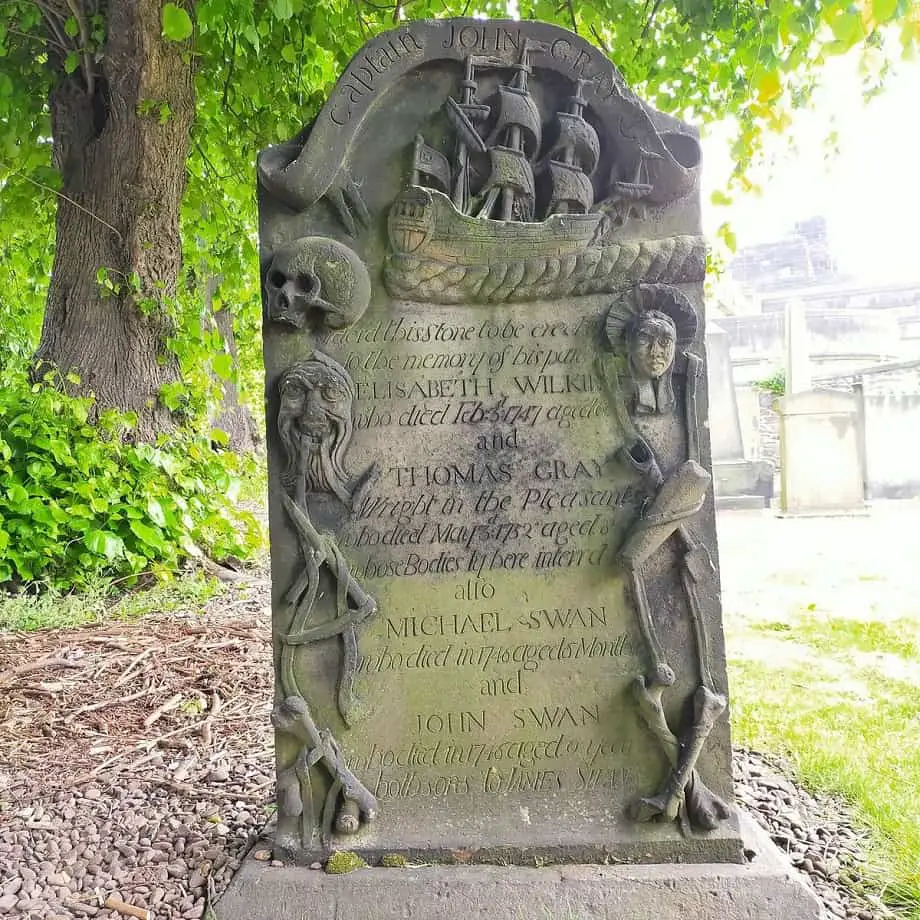
As you huff and puff up the main steps, just turn your head to the left and take in the stunning monument to the Gray family.
Bedecked with a huge ship and more symbols of memento mori than is perhaps necessary, this gravestone is a monument to the parents of Captain John Gray who died in the mid 18th century.
Crossed bones, a coffin and a Green Man are just a few of the symbols on this not to be missed gravestone.
CAGED LAIRS
There are over thirty caged lairs on this site, only a few of which however are complete.
The best example is in the form of a full iron cage which always reminds me of the birdcage in Jurrasic Park III, Jurassic World.
Just make your way around the right when you get to the top of the steps, you should be able to spot it from here.
There’s a similar iron cage at East Preston Street Kirkyard, mentioned below.
New Calton Burial Ground | Regent Street | EH7
KIRKYARD OPEN: 24 Hour Access
COST: Free
ACCESS & RESTRICTIONS : A steep site
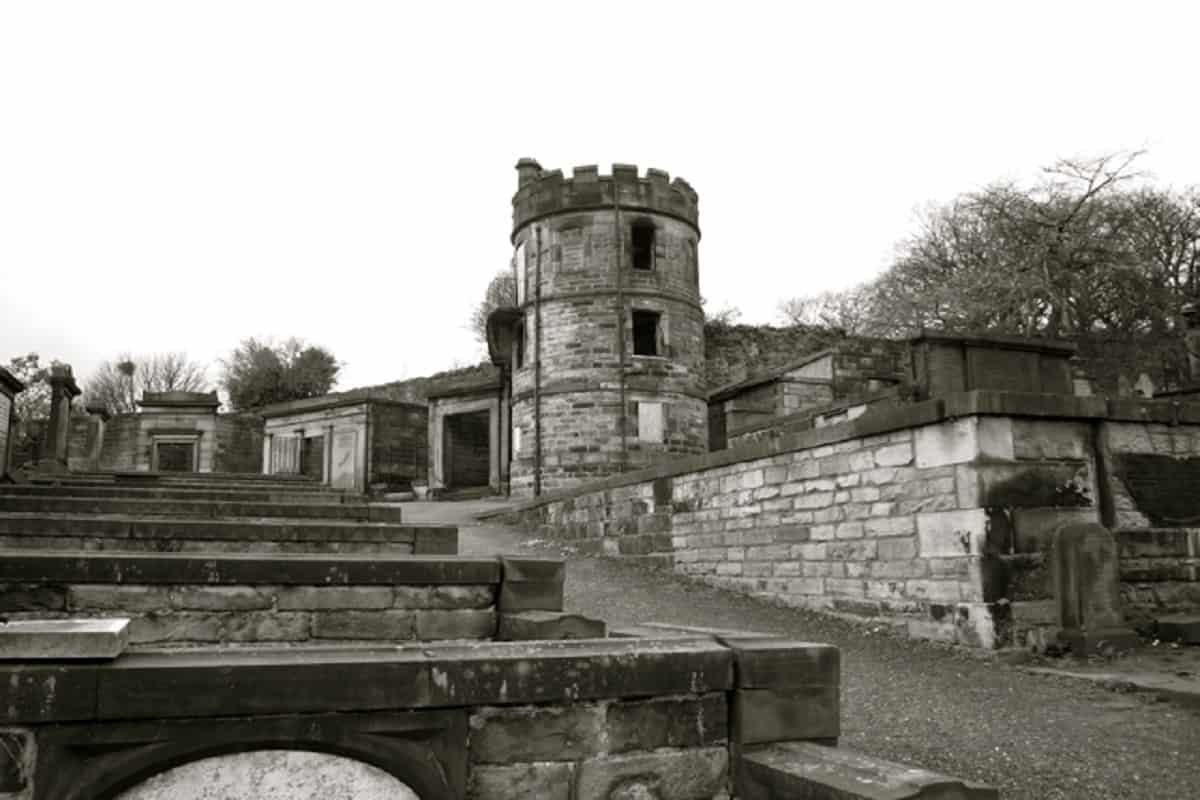
New Calton Burial Ground is the place where those disturbed during the construction of Waterloo Place mentioned above, were reinterred in a site that wouldn’t officially be opened for another two years.
New Calton Burial Ground, opened in 1820, rewards you with near panoramic views of the Old Town. Holyrood Palace, Arthur’s Seat and the Scottish Parliament Buildings all look excellent from this alternative vantage point of the city.
You’ll no doubt notice the large two-story watchtower as you enter the site. A caretaker lived here, something that I’ve not come across anywhere else and there are over 40 caged lairs scatted throughout the site, all erected in an attempt to prevent body snatching.
There’s a spiral staircase wrapping around the outside of the watchtower, unsafe now but how many men have run down here in their haste to capture a body snatcher!
Alas, there is no mortsafe on this site nor I’ve found any record of there ever being one in use here.
Stop for a while and take in the view and atmosphere, and as you do, notice the high walls around the site – another form of body snatching prevention often missed at this historic location.
St Giles’ Cathedral: The High Kirk of Edinburgh |High Street | EH1
KIRK OPEN: Open daily from 10am – 6pm weekdays, Saturday 9am – 5pm, Sundays 1pm – 5pm
COST: Free but a £5 donation is suggested. There is no charge for the Thistle Chapel but numbers are restricted.
ACCESS & RESTRICTIONS: None
ADDITIONAL THINGS TO DO: Guide Rooftop Tours (£), Guided Walking Tours, Thistle Chapel.

You can’t visit the Old Town without stepping inside the iconic St Giles’ Cathedral.
Although there are no ghost stories linked to St Giles’ (that I could find), the history of the Cathedral is part of the rich fabric of Edinburgh and you can quite happily spend a few hours here and not notice it.
Once within a hairsbreadth of the infamous Tolbooth Prison where criminals came to await their fate, St Giles’ Cathedral is amongst one of Edinburgh’s most visited locations.
Within its walls are over 66 Green Men, carvings that have either a human or cat-like face which symbolises a renewed life springing from death, hidden in pillars or the vaulted roof.
You can still get a glimpse of them if you know where to look, the best places being:
Burials within St Giles’ itself stopped after 1560 and of the 100 memorials that lined the walls in the Cathedral, only five relate to people who are buried inside.
When he died in 1572, John Knox, minister at the Cathedral and preacher of the Scottish Reformation wished to be buried within 20 feet of St Giles himself.
But as burials inside the Cathedral had ceased many years previous, he was buried outside the wall of the Cathedral instead.
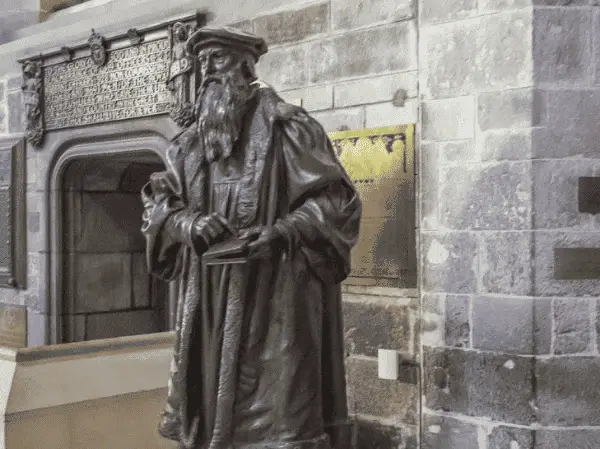
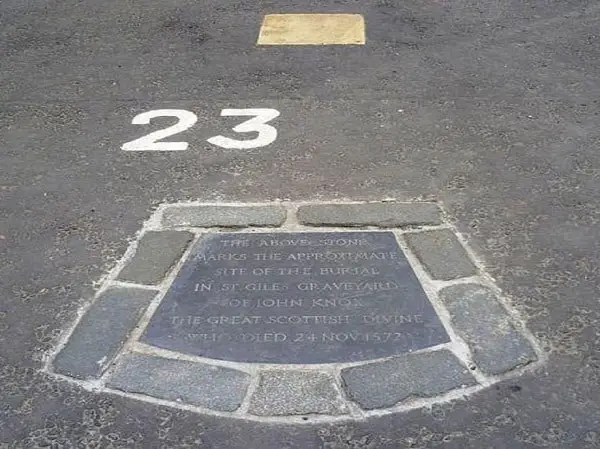
Knox’s statue, which dates to a very recent 1902 can be seen in St Giles’ while his grave can be located outside in what is now the car park, in space No. 23.
Yes, that is right, his grave lies under the Cathedral car park. There’s a plaque, so you shouldn’t miss it unless a car is parked on top of it…
Back out onto the Royal Mile and before leaving St Giles’, look down and find the Heart of Midlothian.
A brick mosaic marks the former entrance to the Tolbooth Prison which is outlined in the pavement by a series of metal studs.

If you want to make like a local, spit on the heart as you walk past. It’s said to bring good luck, but a Henderson says in Black Markers, just don’t lick it!
The Tron Kirk | High Street | eH1
KIRK OPEN: Daily 10am – 6pm. There are NO church services here
COST: Free
ACCESS & RESTRICTIONS: None
A place where minor criminals were once punished, The Tron Kirk has been a sight on the Royal Mile for over 400 years.
It was a place once surrounded by tenements and closes before they were pulled down in the late 18th century, a place that was home to Edinburgh’s first body snatchers, Jean Waldie and Helen Torrence.
These women, down on their drink would murder 9-year old John Dallas Jnr in 1751, agreeing to sell his body to three medical students for the paltry sum of 5 shillings.
After two nights of happily dissecting the body, three students became aware of rumours that a murder had been committed and unceremoniously dumped John’s small body in a close off Libberton’s Wynd.
Quickly arrested, the ladies awaited their fate in the Tollbooth Prison next to St Giles.
Sadly, The Tron is today on the Historic Environment Scotland Buildings at Risk register despite its once dominating presence in the city.
Edinburgh Castle Dog Cemetery | Castlehill | EH1
KIRKYARD OPEN: Open as part of the Castle. From 9.30am – daily
COSTS: From £15.50 per adult, £12.40 per child
ACCESS & RESTRICTIONS: Not open to the public but can be viewed from the Castle’s Argyll Battery
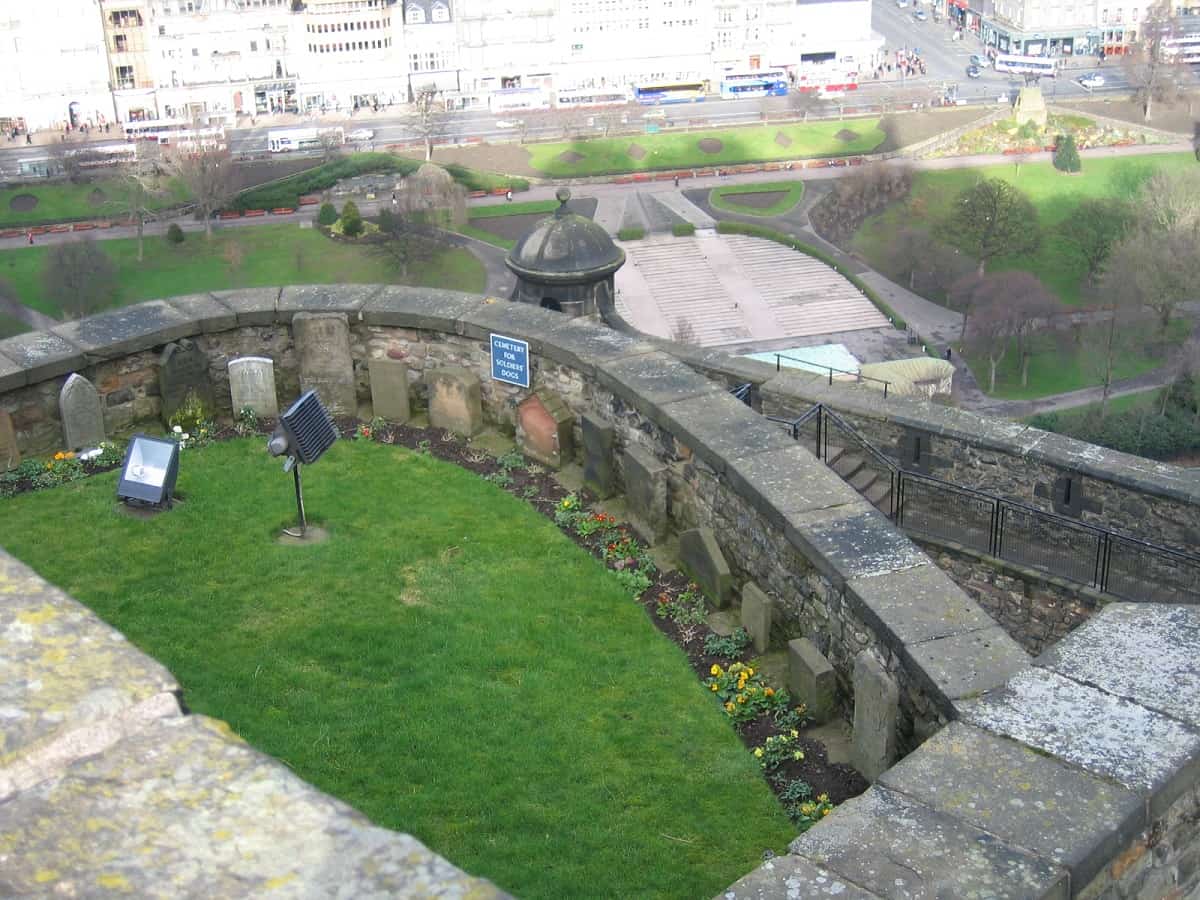
This wee cemetery is a little unusual but and is actually part of Edinburgh Castle. Although closed to the public and can only be seen when viewed from the Argyll Battery.
Used as a cemetery since Queen Victorian’s reign (1837 – 1901), there are over 15 headstones in the small enclosure, with burials of not only Officer’s dogs but also dogs who were regimental mascots such as:
We also have Scamp, Ram and Gyp the Crown Room dog.
It is said that a black dog surrounded by a misty glow haunts the grounds of the Castle and has been spotted on a number of occasions. Barking and howling have also been heard coming from the cemetery, thought to be from a dog buried long ago.
ST MARGARET’S CHAPEL
If you’re at the Castle then it would be crazy not to step inside Edinburgh’s oldest surviving building, St Margaret’s Chapel.
Still used for weddings and christenings and once used to store gun powder, the chapel can be visited as part of your tour to the Castle.
Queues to the Castle can be long at times and if you’re only in Edinburgh for a short while, this can eat into your free time. You can skip the line and link this in with a guided tour of the Castle that lasts about 1.5 hours. Book your tour here.
I tend to do the Castle on my own when I head to Edinburgh, and I get there super early to (try) to beat the crowds, but if you’re not familiar with Edinburgh Castle, then you may enjoy doing a tour such as this.
places nearby
If graveyards are your thing then I see no reason why I shouldn’t mention these extra few locations that as either on the edge of the Old Town or out on a limb and can easily be included if you have time.
St Cuthbert’s Kirkyard | Lothian Road | EH1
KIRKYARD OPEN: 24 Hour Access
COST: Free
ACCESS & RESTRICTIONS: Steps down to the site but good paths
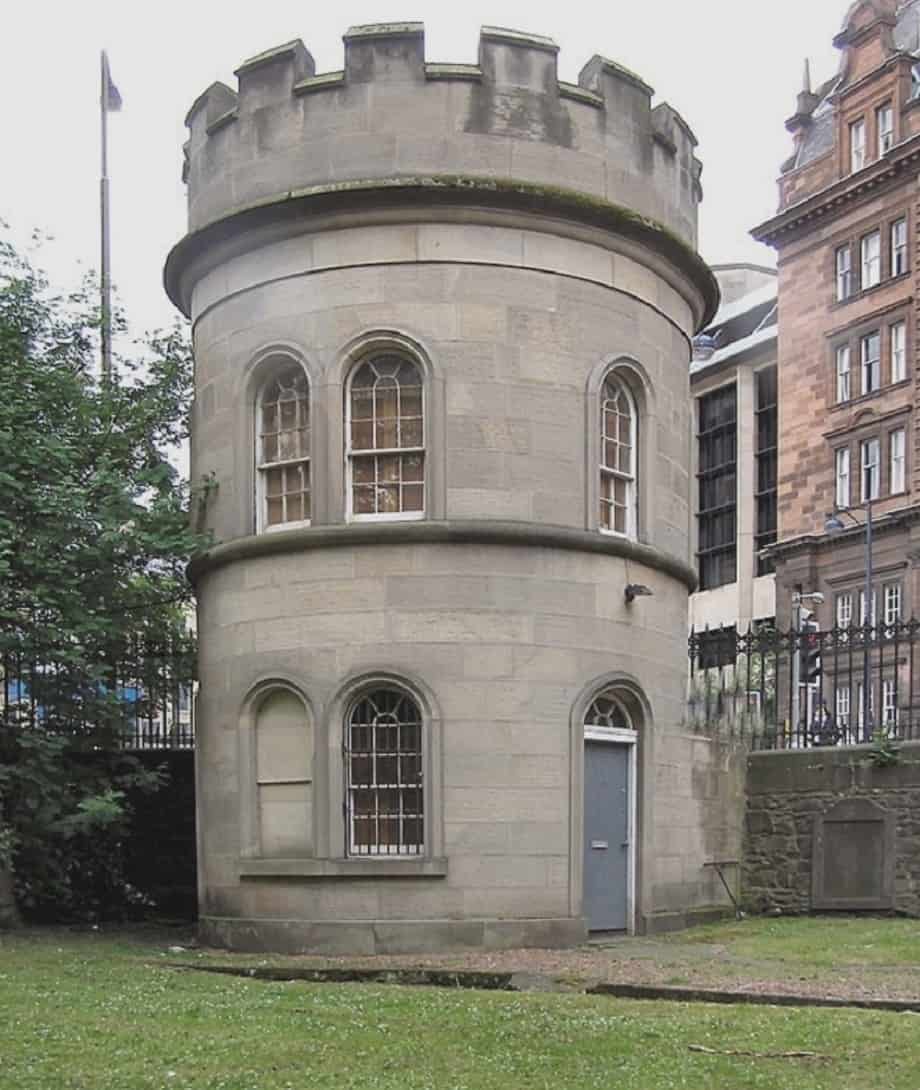
St Cuthbert’s, a place of worship since the Dark ages, is a gem of a place, slightly tucked out of sight to the thousands of people who march past its watchtower daily.
St Cuthbert’s was founded in the 7th century, and there’s been a parish church here ever since AD 670. Once known as The West Kirk, a small mound called ‘Bairn’s Knowle’, a place where children were once buried, is all that is left of the original burial ground. The present Kirk dates from 1892.
Once in the rural outskirts of the city, during the 18th and 19th centuries, St Cuthbert’s became a favourite among Edinburgh’s body snatching fraternity.
Raids here were amongst the earliest in Edinburgh and as the rich used caged lairs to ensure a more secure burial, the Kirk itself installed some anti body snatching prevention of its own:
You can read a deeper history of body snatching at St Cuthbert’s elsewhere on my site and lose yourself in the dark work of body snatching for a while.
NOTABLE GRAVES AT ST CUTHBERT’S
Just like Greyfriars and Old Calton Burial Ground, St Cuthbert’s is awash with skulls, crossed bones and the crossed tools of the sexton; spades and turf cutters.
DESIGNER OF THE SCOTT MONUMENT | GEORGE KEMP
Here lies the body of George Meikle Kemp, designer of the famous Scott Monument in Princess Street Gardens.
Over 1000 mourners attended Kemps’ funeral after his body was found following a dreadful accident where he became disorientated in the fog and fell into the Union Basin Canal.
His grave now faces the monument he never got to see completed so that he may gaze on it for eternity.
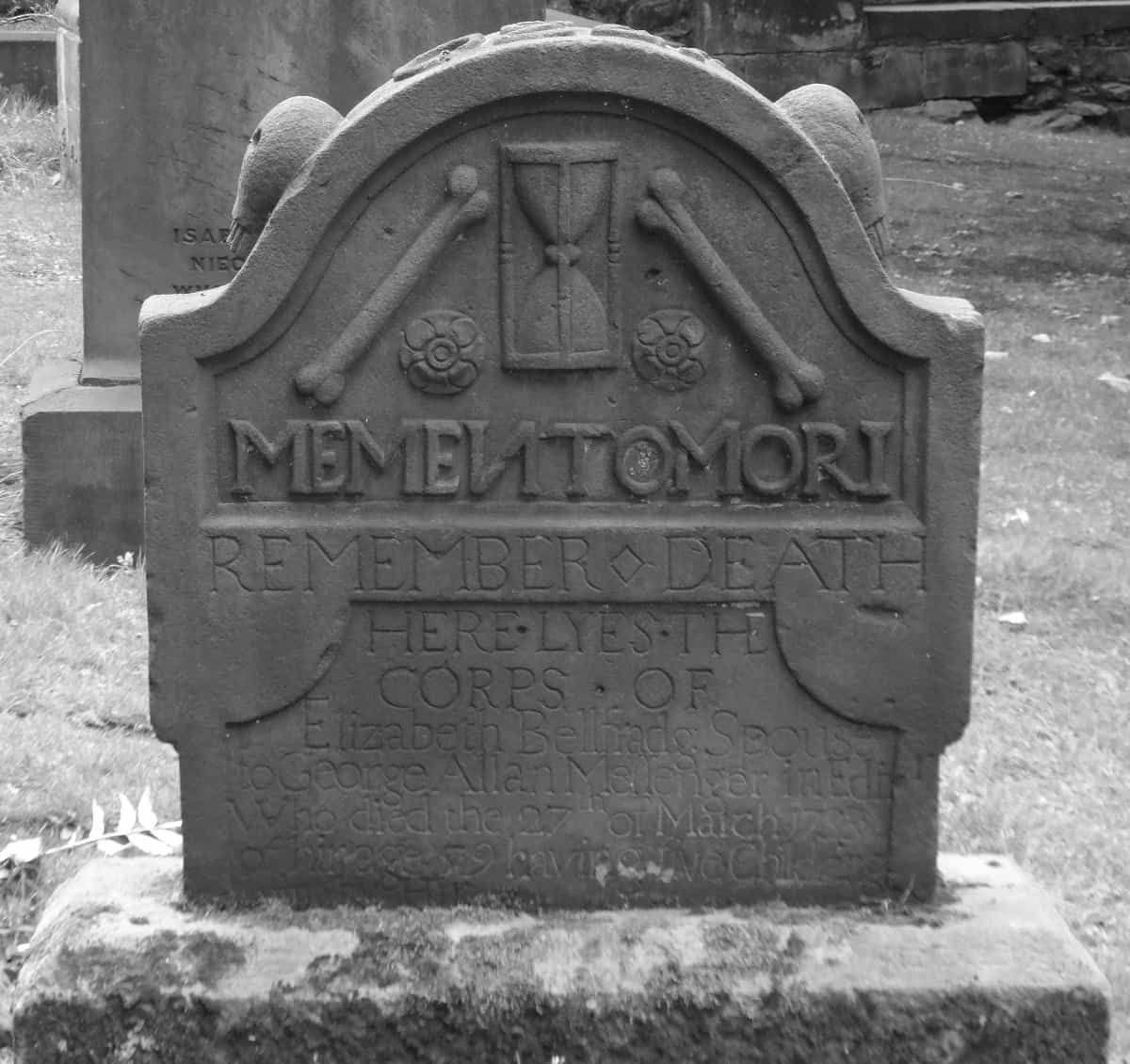
Other graves to keep an eye out for include:
Buccleuch Parish Burial Ground | Chapel Street | EH8
KIRKYARD OPEN: 24 Hour Access
COST: Free
ACCESS & RESTRICTIONS: Level ground & grassed area
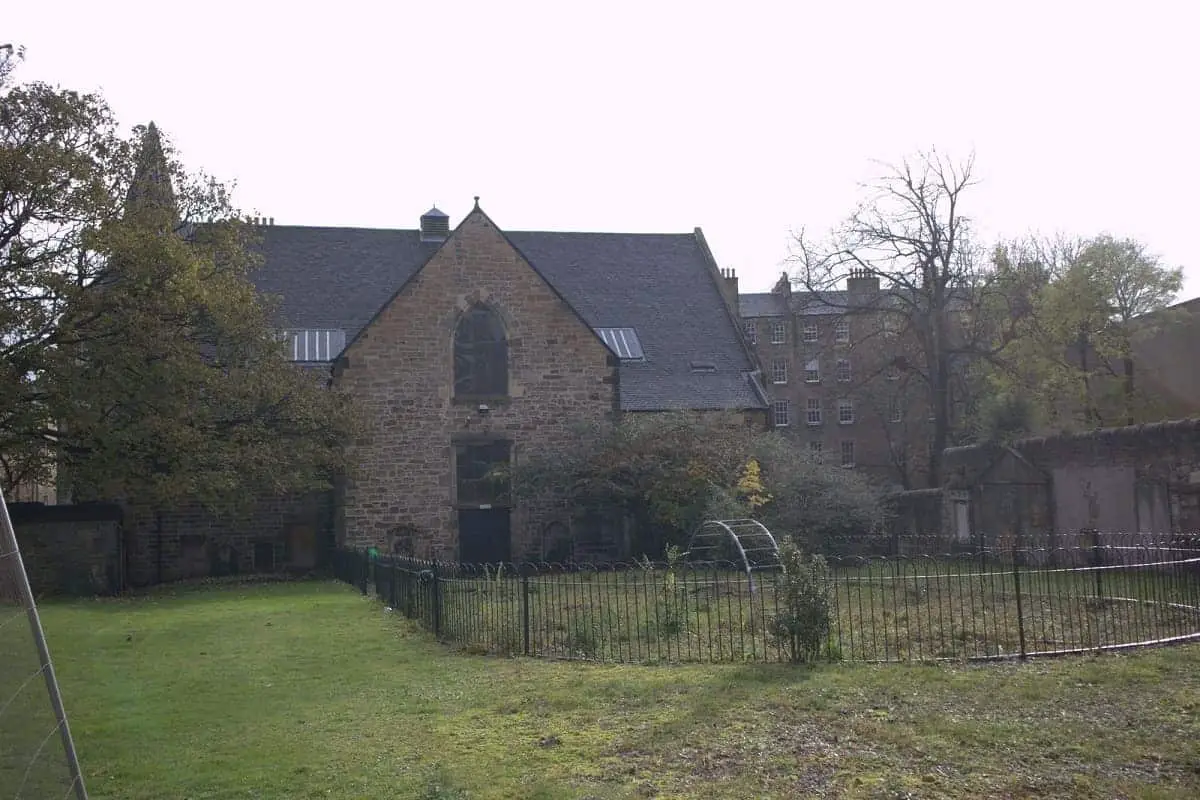
Little, if anything is left of the graveyard at Buccleuch which opened in 1764 and although it’s quite a bit out of our way, it is worth dropping into for the few caged lairs and its link to Deacon Brodie.
Not an attractive site, you may only stay here for about 10 minutes before moving on but there are a few caged lairs, admittedly in a poor state of repair, as you enter the site and monuments hanging on the surrounding wall.
The church hall, once rented out to Southside Roller Skating Academy, has now been built on and today there’s a children’s playground in its place, slap bang in the middle of the graveyard.
Disappointingly, there has never been a gravestone for this infamous Deacon Brodie, the man who is said to inspire Robert Louis Stevenson’s Dr Jekyll and Mr Hyde.
Executed at the Tolbooth Prison in 1788 for raiding the Excise Office on Canongate, Deacon Brodie now has a pub named after him halfway up the Royal Mile.
Well worth a visit if you can get a seat!
East Preston Street Graveyard | East Preston Street | EH8
KIRKYARD OPEN: 24 Hour Access
COST: Free
ACCESS & RESTRICTIONS: Paved site with good access
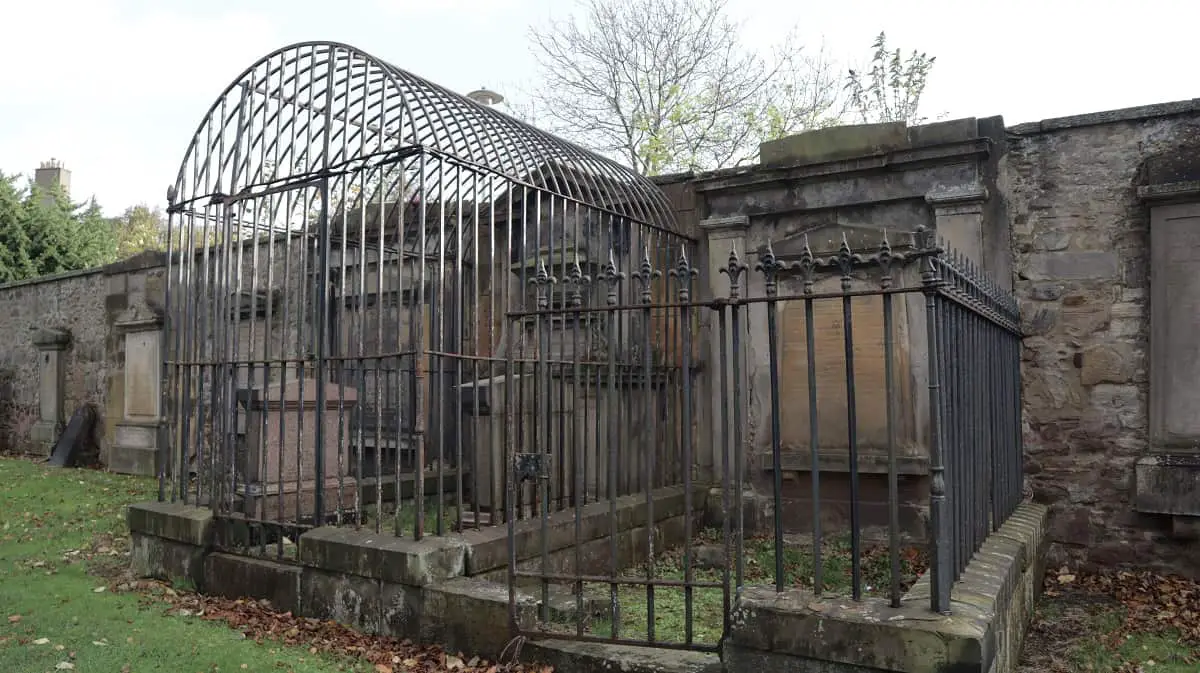
Built in a year when body snatching was still rife in the city and nine years before murderer William Burke was dangling from the gallows in the Lawn Market, East Preston Street is home to some fabulous body snatching prevention.
There are two impressive relics to be found here which makes the slightly out of the way location well worth the trip.
The two-story watchtower is the first and only watchtower I’ve seen with a cooking range in it and if you’re lucky enough to walk up the outer staircase as I was, then the view across the graveyard is superb.
If you do look through the broken windows to take a closer look at the cooking range, please be careful you don’t cut yourself on the broken window glass still in the pane.
You simply would not be forgiven if you went to the site and told me you’d missed the full iron caged lair that you can see as you turn away from the watchtower.
This even rivals the one at Old Calton in my opinion, but I’ll let you be the judge of that.
Note the inscriptions across the lintels on the caged lairs, and the gothic feel to some as you step inside. Some bare the date 1820, the year the graveyard opened, built after Buccleuch was considered overcrowded and closed its doors to all future burials.
*I’m indebted to Charlotte Golledge’s books for some of the more intricate details contained within this blog post.
HERE’S SOME OF MY FAVOURITE GRAVEYARD GUIDES
There are loads of books out there on Edinburgh’s Graveyards, and it can be hard to pick one, especially since we all have our favourites.
I find the ones listed below invaluable when I’m researching my own work or trip and I recommend them regularly when asked.
Gravestone Symbolism: Memento mori symbolism can be a bit of a minefield at times and I find using Betty Willsher’s Understanding Scottish Graveyards helps me immensely. It points out the features you may come across when wandering through graveyards so even those partially weathered stones can be deciphered. Hopefully.
Edinburgh Graveyards: Where to start! I’ve bought a few books in my time but at the moment I’m finding Charlotte Golledge’s Greyfriars Kirkyard and Jan-Andrew Henderson’s Black Markers particularly enjoyable.
Body Snatching: To help you explore Scotland and its links to the body snatching trade, then Geoff Holder’s Scottish Bodysnatchers: A Gazetteer shouldn’t leave your side. Mine is battered and torn now, and although a little dated, I take this on EVERY trip I go on.



